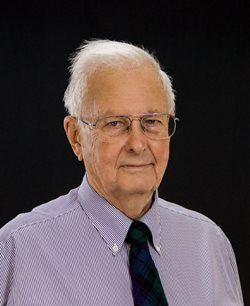James E. Faller
About Optica
In Memoriam: James E. Faller, 1934 - 2023
14 June 2023

James Elliot Faller, Optica Fellow, passed away on 14 June 2023 at the age of 89. Faller was an experimental physicist who made significant contributions to precision measurements, experimental relativity, and innovative instrumentation. He was an internationally renowned physicist in the Quantum Physics Division of the National Institute for Standards and Technology and a Fellow of JILA (University of Colorado Boulder and NIST).
Faller was born on 17 January 1934 in Mishawaka, Indiana. He graduated from the University of Indiana in 1955 with an AB in Physics (summa cum laude). He obtained his MS (1957) and PhD (1963) degrees in the storied Princeton physics group led by RH Dicke. After an initial postdoctoral appointment at JILA (1963-1966), Faller held faculty appointments at the Wesleyan University Department of Physics from 1966 until 1972, when he returned to JILA as a Fellow and NIST staff scientist. After serving terms as Chairman of JILA (1995-56) and Chief of the NIST Quantum Electronics Division (1996-2004), Faller retired in 2006. He held a position as a Visiting Professor at the University of Glasgow from 2001 until 2023.
Faller's scientific career spanned precision measurement of physical constants, fundamental tests of basic laws, and innovative instrumentation. Starting with his doctoral thesis at Princeton and continuing with numerous graduate students, he developed a succession of absolute gravimeters for measuring the Earth's gravitational acceleration 'g.' The core idea of his doctoral thesis was interferometrically measuring the descent of a dropped object. He improved on that original idea by incorporating a stabilized laser, a reference mass on a suspension with long-period vibration isolation (aka, superspring), and a throwing system that measured both upward and downward travel with a high repetition rate. The gravimeters were all more-or-less portable to facilitate gravity mapping and side-by-side comparisons at reference locations. Both research and commercial versions became standards for gravimetry, geodesy, and fundamental tests of the 'fifth force' and Newton's Law of Gravitation.
Other significant contributions made by Faller included his proposal for precision ranging to the Moon using lasers and retroreflector arrays left on the Moon by the Apollo 11, 14, and 15 missions, his development of multiple torsion pendulums for improved Eötvös experiments, and contributions to the quartz-fiber final suspensions and the active seismic isolation systems incorporated into Advanced LIGO. Faller also performed other notable precision measurements, such as a test of Coulomb's Law and upper limit on the photon rest mass, a measurement of the Newtonian Gravitational Constant ('G'), and a test of the anisotropy in the speed of light.
In 1981, Faller and Peter Bender proposed the first workable concept for a space-based, gravitational-wave detector that would operate in the millihertz band where the richest array of sources is found. Working with Dr. Bender and others, he pioneered the conceptual design that became the Laser Interferometric Space Antenna (LISA). LISA promises to detect massive black hole binary systems throughout the Universe and other gravitational-wave sources that are undetectable by ground-based instruments. LISA is now a major space mission in the European Space Agency's program, with an anticipated launch date in the latter half of the 2030s.
Faller was a mentor to many students and postdocs. He will be remembered for his ability to engage and inspire students to find creative instrumental solutions for major experimental challenges in ways that transformed their careers.
Faller received many prizes over his career, including the National Bureau of Standards Precision Measurement Award (1970), the Arnold O. Beckman Award of the Instrument Society of America (1970), the NASA Group Achievement Award (1973), the NASA Exceptional Scientific Achievement Medal (1973), the Department of Commerce Gold medal (1990), and the Joseph F. Keithley Award (2001). He was made a Fellow of Optica for pioneering contributions to fundamental measurements, including lunar laser ranging, measurement of g and G, test of Coulomb's law, and LISA. The American Physical Society, the American Geophysical Union, and the American Association for the Advancement of Science also recognized him as a Fellow.
Outside his career, Faller was a passionate devotee of Medieval, Renaissance, and Baroque music and played the recorder for many decades. He was an avid sports fan, particularly of tennis and basketball, and lectured occasionally on the nexus of sports and physics. Faller is survived by his wife, Jocelyne Bellenger, his brother Larry Faller and his two sons, William and Peter Faller.
To learn more about the career and accomplishments of Dr. James E. Faller, a complete obituary is available from JILA.
Optica mourns the loss of Dr. James E. Faller.
